
Sumer: Where Written Language, Arithmetic and Civilization Were Born
The Sumerian civilization (known also as Sumer) was one of the earliest civilizations in the world. This ancient civilization emerged in the region of southern Mesopotamia (modern day southern Iraq), between the Tigris and Euphrates River. The Sumerian civilization began around the 4th millennium BC and ended around the 24th century BC, when the whole of Mesopotamia came under the control of the Akkadian Empire.
The Sumerians re-emerged during the 22nd century BC and ruled southern Mesopotamia once more. The Third Dynasty of Ur that they established, however, did not last for long and fell after about a century. Although Sumerian dominance in Mesopotamia ended definitively this time, its numerous innovations benefitted subsequent Mesopotamian civilizations, and its legacy can still be felt even today.
Who Were the Sumerians?
The name ‘Sumerian’ was first used by the Akkadians. The Sumerians in fact referred to themselves as sag-gi-ga, which translates to mean ‘black-headed people’, and the land they inhabited ki-en-gir, meaning ‘land of the civilized lords’. Today, scholars use the term ‘Fertile Crescent’ to describe the arc of land that stretches from the Gulf in the east to Egypt in the west. This area covers the areas of modern Iraq, the Levant, and the Nile Valley, and is considered to be the cradle of civilization. As part of the Fertile Crescent, the soil of southern Mesopotamia was fertile and suitable for agriculture, which appeared during the Neolithic Revolution. As a result, humans began to settle in the region.
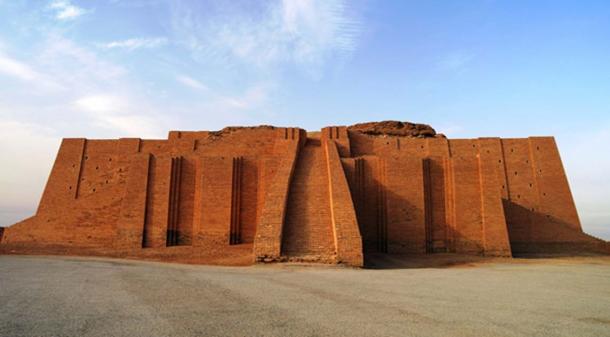
Sumerian civilization ruins, temple in Iraq. (homocosmicos /Adobe)
According to the archaeological record, there were several cultures that occupied the area of southern Mesopotamia prior to the rise of the Sumerian civilization. Archaeologists are able to differentiate these cultures according to the artifacts that have been excavated. In particular, these cultures have been identified based on the stylistic differences of archaeological pottery. In brief, there were three distinct periods preceding the Sumerian civilization – the Ubaid period, the Uruk period, and the Jemdet Nasr period, each one taking its name from the site where the culture was first identified.
- The Ascension of Gilgamesh: Did the Epic Hero Actually Exist?
- Eridu: The Sumerian Garden of Eden and the Oldest City in the World?
- Leaving an Impression: Revealing the Intricate Story of Sumerian Cylinder Seals
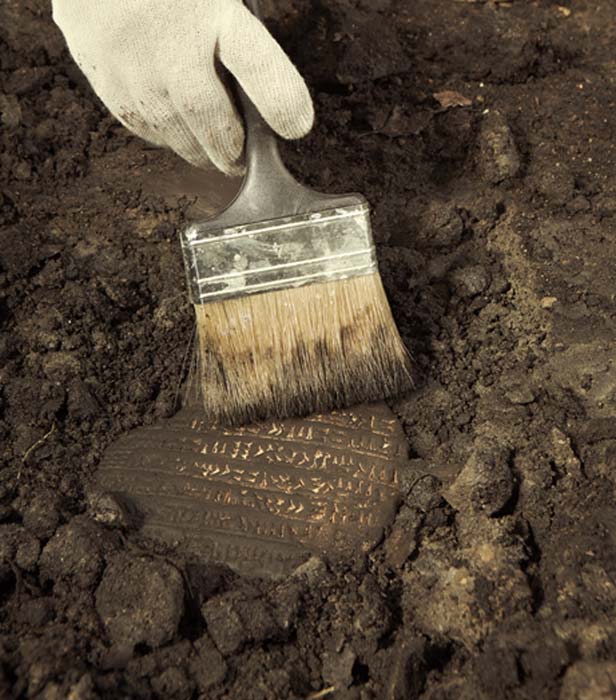
Artifacts that have been excavated of the Sumerian civilization have been identified based on stylistic differences. (Couperfield / Adobe)
The Ubaid period lasted from around 5000 to 4000 BC, while the Uruk and Jemdet Nasr periods from around 4000 to 3100 BC, and 3100 to 2900 BC respectively. During each period, features of ‘civilization’ were emerging, though not yet fully developed. As an example, during the Ubaid period, most people lived in small village communities, though towns were beginning to emerge as well, a precursor to the urban centers that would be established later on. Another example is the use of seals in all three periods, which shows some administrative complexity and perhaps even social stratification.
The Sumerian civilization emerged around 2900 BC and lasted until about 2350 BC when it was replaced by the Akkadian Empire as the dominant power in the region. This period is also referred to as the Early Dynastic period. One of the major differences between this period and the preceding ones is that by this time, most people had abandoned village life and settled in walled urban centers. This may be regarded to be the beginning of the Sumerian city states, which consist of a large urban center (or several of them) by a hinterland. Some of the more powerful and better-known city states of the Sumerian civilization during this period include Ur, Uruk, Lagash, and Kish.
One of the consequences of the rise of these city states is that Sumerian society became stratified. It is unclear as to the extent of social stratification before the Early Dynastic period. For instance, scholars are divided as to whether society during the Ubaid period was egalitarian or hierarchical.
By the time of the Early Dynastic period, however, social stratification had already firmly taken root. This is evident in the fact that the city states were ruled by kings, whose office was hereditary. This is seen, for instance, in a document known as the Sumerian King List. This document combines historical, legendary, and mythical information, and contains lists the rulers of the various dynasties of Sumer and its neighbors, along with the supposed length of their reigns.
The Rulers of the Sumerian Civilization
The Sumerian King List was written in Sumerian and shows that the people of ancient Mesopotamia believed that kingship was conferred upon human beings by the gods. The list begins with a group of kings known as the ‘antediluvian rulers’, who are believed to be mythical figures. Although no historical evidence has been found for their existence as yet, it is possible that they were historical rulers who were later mythologized by the Sumerians.
The list continues with the various dynasties of the Sumerian civilization and its neighbors, for instance that of Mari, and Akkad, and ends with the Dynasty of Isin, which flourished between the 20 th and 18 th centuries BC. Incidentally, there is a sole female ruler in the Sumerian King List, Kubaba (meaning ‘woman tavern keeper’), who was also the only ruler of the Third Dynasty of Kish.
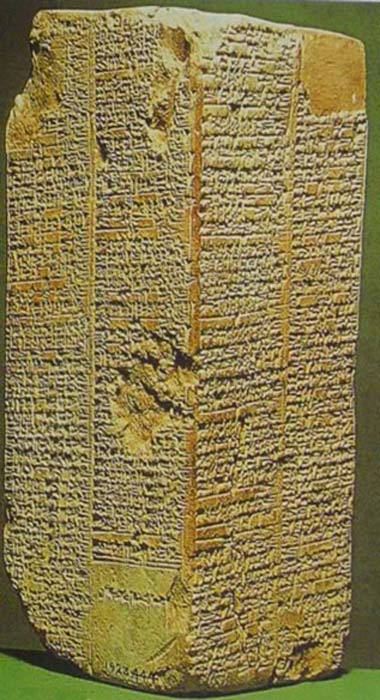
The Sumerian king list. (Taiwania Justo / Public Domain)
As the rulers of the Sumerian city states obtained their right to rule from above, they maintained a close relationship with the religious authorities. Each city state had its own patron deity and the temples of the gods occupied the heart of the city. The central location of these temples, in addition to the fact that they were built as towering structures known as ziggurats, meant that they dominated the cityscape of the Sumerian city states and were visible from both near and far.
The temples of the Sumerian city states had power not only over religious matters but were also major stakeholders in the economy of the cities. In theory, the ruler, being the representative of the gods, had ownership of all the land. In practice, however, it was impossible for the king to manage all the land by himself. Therefore, the task of managing and organizing the agricultural land was given to the temples.
Although some land was held privately, this was the exception rather than the norm. The temples became the principal landowners of the Sumerian city states and the farmers depended on them for their livelihood. The temples managed all aspects of the agricultural cycle, from the planting, all the way to the harvesting, and the redistribution of the agricultural produce.
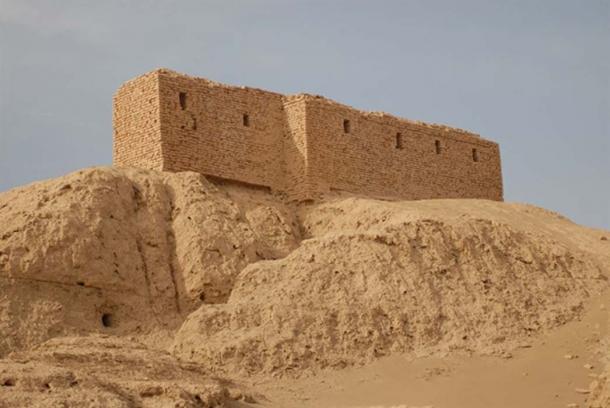
Ruins from a temple of the Sumerian civilization in Naffur, Iraq. Said to be the site for the meeting of Sumerian gods, as well as the place that man was created. (Walthall / Public Domain)
Many important innovations were made by the Sumerians in order to ensure that the management of the agriculture by the temples went smoothly. One of the most significant of these was the development of the cuneiform script, which is the earliest known writing in the world. This script was originally developed as an administrative tool and was used to keep track of the flow of goods, including agricultural produce.
In time, the Sumerians would use this script for other purposes as well, for instance, for the writing of scientific or literary texts. More importantly, however, is the fact that this invention long outlived the Sumerian civilization. The cuneiform script was adopted by succeeding civilizations, including the Akkadians, Babylonians, and Assyrians for the writing of their own languages.
It was also thanks to the temples that progress was made in various fields of knowledge. One of these areas, for instance, is arithmetic. Knowledge of arithmetic made it easier for the scribes to keep a record on the goods that were coming in and going out of the temples. Prior to this, the amount of goods was represented by clay tokens.
Once arithmetic was developed, however, they could be represented as numbers on clay tablets. Arithmetic also contributed to the invention of the calendar and clock. The Sumerians invented several number systems, including the sexagesimal system (base 60), which became the standard number system of the Sumerian civilization. Using this number system, the Sumerians invented the clock, with its 60 seconds, 60 minutes, and 12 hours; as well as the calendar, with its 12 months. The impact of these inventions is felt even today.
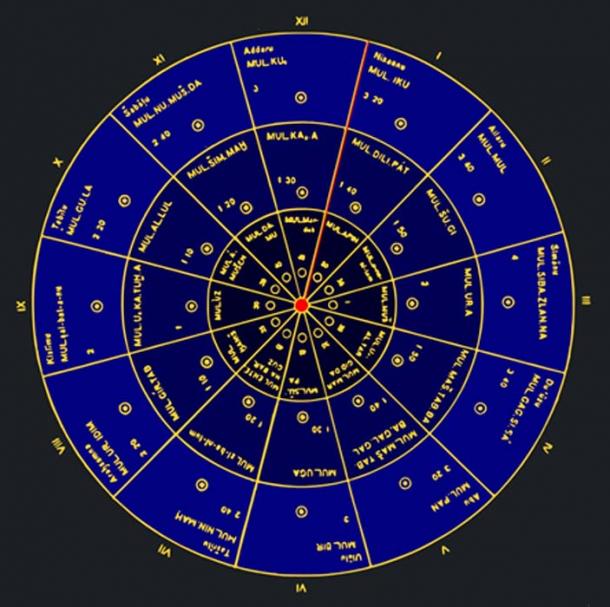
Astronomical calendar for the Sumerian civilization. (Eckhardt Etheling / Public Domain)
Despite the fact that the city states of Sumer shared the same culture and language, they were never unified and were constantly at war with each other. The oldest known historical document is from the Sumerian civilization and has warfare as its subject matter. The Victory Stele of Eannatum, King of Lagash, commonly known as the Stele of the Vultures, was made around 2450 BC, during the Early Dynastic period. This limestone stele, which has survived in fragments, was made to celebrate a victory of the city state of Lagash over its neighboring rival, Umma.
The scenes of the stele depict both historical and mythological events. On one side of the monument, the deeds of men are shown, whereas those of the gods are illustrated on the other side. In a way, the stele is a statement that the victory gained by the people of Lagash was obtained thanks to a combination of human effort and divine protection.
- Instructions of Shuruppak: 4,600 Years Ago, A Sumerian King Instructed His Son on How to Behave
- The Royal Road of the King of the World, and the Ancient Center of the Earth
- Zecharia Sitchin and the Mistranslation of Sumerian Texts
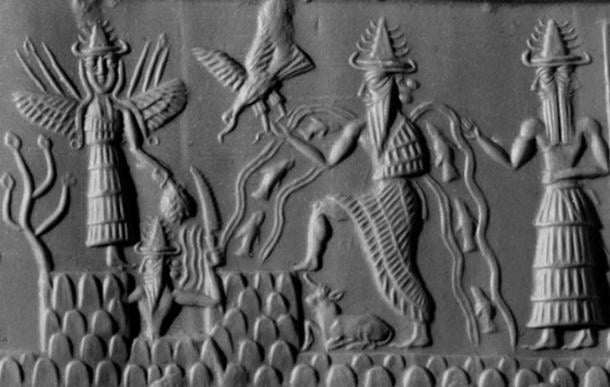
The gods of the Sumerian civilization can be identified as gods by their pointed hats with multiple horns. (Lushess / Public Domain)
In the scene from which the stele receives its popular name, a wake of vultures is shown feasting on the corpses of the fallen enemy soldiers. Below this gruesome scene are inscriptions written in cuneiform, one of which, translated from the Sumerian, reads as “Eannatum struck at Umma. The bodies were soon 3600 in number,” clearly indicating the war between Lagash, whose king was Eannaum, and Umma. War between the two city states broke out supposedly due to a border dispute.
Another scene has been interpreted as a victory parade. In this scene, there is a man, assumed to be Eannatum, mounted on a chariot. The king is shown holding in one hand a pike or spear and has a quiver of javelins ready too. Behind Eannatum are two rows of soldiers, who are armed with spears and battle axes. In a third scene, the soldiers of Lagash are depicted conducting funeral ceremonies for their fallen comrades.
Internal Conflicts Affects the Sumerian Civilization
The continuous conflict between the Sumerian city states led to developments in military technology. This is visible, for instance, in the defensive walls that were constructed to protect the cities from enemies. From the Stele of the Vultures, we see that the Sumerians had invented the chariot and likely used it during battles.
Moreover, it has been speculated that siege warfare and the phalanx formation were invented by the Sumerian civilization. One of the major drawbacks of this constant warfare, however, was that the Sumerians lacked unity, and were therefore vulnerable to external threats.
This threat from without took the form of Sargon of Akkad, the founder of the Akkadian Empire. The Akkadians were a distinct cultural group from the Sumerians who inhabited the area to the north of Sumer. During 2350 BC, Sumer was conquered by the Akkadians, and Sumerian dominance in the region came to an end. The Akkadians would in turn be defeated by the Gutians around 2150 BC. After a century or so of Gutian rule, the Sumerians were once more in control of their homeland.
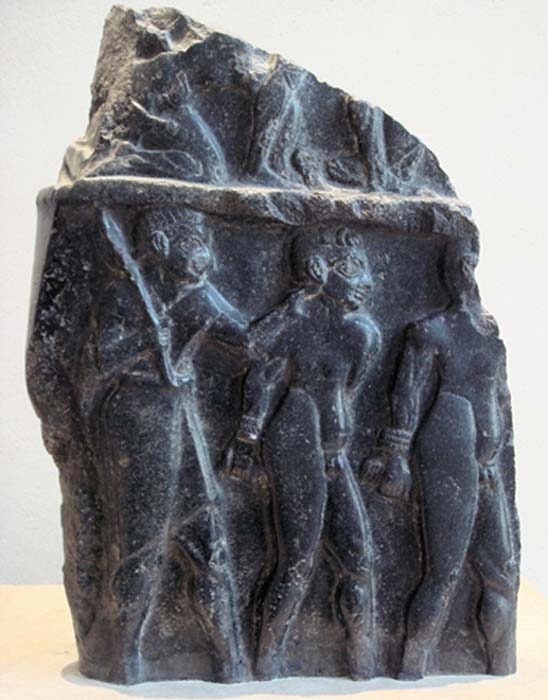
The Akkadians were a threat to the Sumerian civilization. Prisoners escorted by a soldier, on a victory stele of Sargon of Akkad. (पाटलिपुत्र / Public Domain)
The Third Dynasty of Ur (known also as the Neo-Sumerian Empire) was founded around 2112 BC. The overthrow of the Gutians is attributed to Utu-Hengal, the ruler of Uruk, who defeated the last Gutian king, Tiriqan, and two of his generals. Utu-Hengal established the Fifth Dynasty of Uruk and was its only ruler, according to the Sumerian King List. Utu-Hengal’s reign was short, and he was succeeded after his death by Ur-Nammu, his brother, who established the Third Dynasty of Ur. Initially, Ur-Nammu was the governor of Ur under Utu-Hengal. It is unclear, however, as to how he became king after the latter’s death.
The Third Dynasty of Ur lasted for about a century and the Sumerian King List records five rulers as belonging to this dynasty – Ur-Nammu, Shulgi, Amar-Su’ena, Shu-Sin, and Ibbi-Sin. Although the Sumerian return to power did not last for long, it managed to make some significant contributions to the history of civilization. The most important of these is a document known as the Code of Ur-Nammu, which is considered to be the oldest surviving law code in the world. This law code was written on a clay tablet in Sumerian and was made either during the reign of Ur-Nammu or during that of his successor, Shulgi.
Sumerian dominance in southern Mesopotamia came to an end permanently around 2004 BC. The Third Dynasty of Ur seems to have been a prosperous period for the most part. The situation, changed, however, during the reign of its last king, Ibbi-Sin and the collapse of this dynasty is recorded in a number of contemporary sources.
From these sources, we learn about how Ishbi-Erra succeeded in replacing Ibbi-Sin as the ruler of Sumer. Ishbi-Erra was a general or high official from Mari, who approached Ibbi-Sin while the latter was waging war in Elam. By emphasizing the threat posed by the Amorites, Ishbi-Erra convinced the king to allow him to defend the city states of Isin and Nippur. Ishbi-Erra dealt with the Amorite threat successfully and began to increase his own power.
In time, Ishbi-Erra became strong enough to rule independently. In the meantime, the territory controlled by the Third Dynasty of Ur decreased gradually and the Ur itself was besieged by the Elamites. Ibbi-Sin was defeated, led away as a captive, and disappears from history. While Ishbi-Erra established the Dynasty of Isin, which lasted from around 2017 to 1794 BC, he did not control the whole of southern Mesopotamia and other local rulers emerged. Thus, Sumer was fragmented once more, and would only be unified again under the First Babylonian Empire.
Top image: Sumerian civilization artifact. Source: swisshippo / Adobe
By Wu Mingren
References
Andrews, E. 2019. 9 Things You May Not Know About the Ancient Sumerians. [Online] Available at: https://www.history.com/news/9-things-you-may-not-know-about-the-ancient-sumerians
Anon. 2001. The Sumerian King List. [Online] Available at: http://etcsl.orinst.ox.ac.uk/section2/tr211.htm
DHWTY. 2017. The Code of Ur-Nammu: When Ancient Sumerians Laid Down the Law, Everyone Obeyed. [Online] Available at: https://www.ancient-origins.net/artifacts-ancient-writings/code-ur-nammu-when-ancient-sumerians-laid-down-law-everyone-obeyed-009333
Frye, R., von Soden, W., & Edzard, D. 2019. History of Mesopotamia. [Online] Available at: https://www.britannica.com/place/Mesopotamia-historical-region-Asia
Gill, N. 2018. An Introduction to Sumer. [Online] Available at: https://www.thoughtco.com/an-introduction-to-sumer-121074
History.com Editors. 2018. Sumer. [Online] Available at: https://www.history.com/topics/ancient-middle-east/sumer
New World Encyclopedia. 2015. Sumerian Civilization. [Online] Available at: https://www.newworldencyclopedia.org/entry/Sumerian_Civilization
New World Encyclopedia. 2017. Cuneiform script. [Online] Available at: http://www.newworldencyclopedia.org/entry/Cuneiform_script
Pollock, S. 1999. Ancient Mesopotamia. Cambridge: Cambridge University Press.
Rana, V. 2019. Sumerian Civilization and It’s Contributions. [Online] Available at: http://www.historydiscussion.net/world-history/sumerian-civilization-notes-on-the-contributions-of-the-sumerian-civilisation/1899
The Ashmolean Museum. 2019. Sumerian King List. [Online] Available at: https://www.ashmolean.org/sumerian-king-list
The Louvre Museum. 2019. Stele of Vultures. [Online] Available at: https://www.louvre.fr/en/oeuvre-notices/stele-vultures
















Comments
I think a lot of the confusion clears up once you understand (in interpreting the texts) the physical realities and tribal centricity of the Sumerians of those times, a tribalism which in many ways yet carries forward to today. The Sitchen analysis of the Annunaki wars is a key, as is Plato’s account of Atlantis, once you add back the zero to his timeline, which puts the destruction of Atlantis, and that entire fair-haired culture, at 115k BC, correlating with the sudden emergence of the Ice Age (long nuclear winter). So you have an alien assault on Earth on a global scale (as the ruins and subterranean caverns of the Gobi, Indus Valley and other places also account for), and a subsequent infiltration (after the proverbial smoke had cleared) of the black-headed/black-haired people in Sumer, who immediately began taking fair-haired aboriginal women (Atlantean era survivors), and creating a new race of black-haired people, in what is called the dawn of civilization. But it’s obviously a subsequent civilization, that pales in its early condition compared the former/Atlantean and all the megalith stone ruins (and precious metal artifacts) that were left behind. The earliest Sumerian texts talk about making a well of mud bricks, as some type of achievement, and in the Indus Valley and other places, you can still see the bricks laid OVERTOP the broken megalith stone foundations. NO ACCOUNT, Persian or Roman, describes the quarrying, moving, and stacking the huge stones, and so we must accept that that work was done earlier, by the Atlantean era people, who during those times almost certainly had no enemies – it was just them and their pursuit of beauty and their living-god (Zeus-like) culture. So it’s a bit disturbing that the fair-haired aboriginals are essentially ignored, given no credit for what they did, and for the grain-based culture (bread, beer, malt, not-to-mention wine, etc.) that they had that was co-opted by the invaders, who had more a taste for meat. In light of this, history should be entirely re-evaluated, and the Sumerian and all old Bible texts seen essentially as an invader’s log, and struggle to start something anew, on a new planet, where all had previously been destroyed.
Nobody gets paid to tell the truth.
The Sumerians called the uncultivated wilderness about their cities the EDIN. In this location they have man being created by the gods. The myths giving contradicting accounts about man's origins. One account has man in the beginning as a wild hairy, naked beast, roaming animal trails in the EDIN with wild beasts for companions. As he eats grass, and so do they, they are of no danger, both being herbivores (wild cattle and antelope, see Enkidu in the Epic of Gilgamesh). Naked, hairy man has no knowledge of good and evil, for he is unaware it is wrong to be naked in the EDIN, his reasoning and intellect is that of a beast. Another myth has man being created to care for the gods' fruit-tree gardens associated with the cities the Sumerian gods reside in. They tire of the back-breaking labor in clearing irrigation canals of clogging silts, so they create man to be a gardening slave. He will clear the canals of sediments, harvest the crops, and present the garden produce to the gods as daily food offerings at the city temple. The earlier myths have the gods possessing bodies of flesh, they can die of starvation if having nothing to eat. The gods thus created fruit-tree gardens with their cities (apples, dates, figs) to have food to eat. The gods would never expel man from their gardens in the EDIN, for to do so would force the gods to resume the back-breaking toil in EDIN'S city-gardens, a labor they abhorred. The Hebrews in the Book of Genesis are refuting these Sumerian accounts about man's origins. They object to the Sumerian explanation of why man is a sinner. The gods are portrayed as being sinner-gods, they engage in rape of goddesses, incest with their daughters, sex with animals, they lie, break oaths, and generally hold man in contempt, man being made to be a lowly gardening slave. The Hebrew God is portrayed as being just and righteous, he expects man, made in image, to be just and righteous too. Instead of every Sumerian city having a god's garden to provide food for the gods, to keep the gods alive, the Hebrew god is portrayed as making his garden to provide food for man not for god. Yet, in the Bible, we are informed that the Levitical priests in the Temple of Solomon, provide meals to Yahweh-Elohim, twice a day, morning and evening, just as Mesopotamian gods are presented food offerings morning and evening, to keep them alive. It never occurred to the Hebrew as to why it was necessary to provide their God with two meals daily, after all their God is immortal, and cannot die, the purpose of food is maintain life and avoid death from starvation. A number of scenarios, motifs and events associated with a polytheistic EDIN were recast by the Hebrews and associated with a Monothiestic Eden. Via a homophone confusion, Hebrew Eden meaning "delight," the Hebrews apparently misheard and misunderstood the Sumerian word EDIN, meaning "uncultivated wilderness."
Walter R. Mattfeld
Unfortunately for the prevailing theory of the " Fertile Crescent " the oldest human civilization is of
" Old Europe" around the Danube river and further down south among both coastlines of the Aegean
Sea dating back to 6.500 BC.